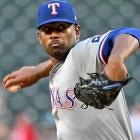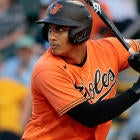
The Houston Astros and Chicago Cubs delivered a blockbuster, Jeffrey Springs has a new ball club, plus the Yankees have a new closer and he's elite. Let's dive a little deeper into each of these trades and what they might mean moving forward as you prep for your 2025 Fantasy Baseball drafts and season.
Kyle Tucker to the Cubs; Isaac Paredes, Cam Smith, Hayden Wesneski to the Astros
Kyl Tucker: No value change
Tucker is the headline of the deal, but for exactly that reason, it doesn't really matter where he plays. This is probably a mild downgrade in his home park, but unless Tucker suffers an unexpected drop in skill in his age-28 season, I have no real reason to think he won't continue to be one of the handful of best players in Fantasy. I don't necessarily expect him to sustain last year's .289/.408/.585 line no matter where he's playing, his underlying stats were better than ever in 2024, so it wouldn't be shocking. Tucker was in the No. 6 spot in my overall rankings before this trade, and that's where he's staying.
Isaac Paredes: The biggest winner
The trade to Chicago was always a bad one for Paredes. Paredes is a power hitter with little power – he was in the third percentile in average exit velocity last season – but he has a terrific approach at the plate, spitting on pitches he can't do anything with and focusing on those he can hit in the air to left field. That's a tough thing to pull off consistently at Wrigley Field, which is 355 feet to the left field corner; it's going to be much easier in Houston, where the Crawford Boxes give him a 315-foot target down the line.
According to BaseballSavant's expected home runs, Paredes would have just 56 homers playing all of his career games at Wrigley; it would be 79 in Houston the highest of any park in the majors. This is the perfect landing spot for Houston, and makes the Astros one of the few team where he could realistically be worth accepting as the centerpiece in a trade for a superstar like Tucker. You can question how valuable a guy can be when his bat is so tied to his home park, but Paredes should go back to being a four-win player in Houston, and he's got a good chance to get back to challenging for 30 homers. In a lineup where he'll likely be hitting in close proximity to Jose Altuve and Yordan Alvarez, it was enough to move him from around 250 in my overall Roto rankings to around 160, as the No. 13 third baseman.
Cam Smith and Hayden Wesneski: The path is a little clearer
Smith was the No. 13 pick in last year's draft and is already Scott White's No. 4 third base prospect for Fantasy. But, if you click over to that article, you'll notice a hiccup: The No. 1 3B prospect was also on the Cubs. The Cubs have a long-term hole at third and could open up space at second base easily enough, but it's just true that Smith has a clearer path to playing time in Houston. It probably won't happen in 2025, as he has played just five games above High-A (and only 12 games at that level), but he might just be the kind of bat that blazes through the minors.
The Cubs didn't exactly have the deepest rotation in the majors, so it does say something that he struggled to consistently crack the rotation there. A chance of scenery could benefit him, and he should at least have a path to the rotation for the Astros, especially if they move Framber Valdez, as rumored. He could be a SPaRP to target in the later rounds of H2H points leagues if so.

Fantasy Baseball Today Newsletter
Your Cheat Code To Fantasy Baseball
You're destined to gain an edge over your friends with advice from the award-winning FBT crew.
Thanks for signing up!
Keep an eye on your inbox.
Sorry!
There was an error processing your subscription.
Devin Williams to the Yankees; Nestor Cortes, Caleb Durbin to the Brewers
Devin Williams: Trevor Megill, you are a top-20 closer!
We can't just assume the Yankees will win more games than the Brewers in 2025 – after all, they won just one more last season and lost that Juan Soto guy, which has to be worth a few wins. The Brewers' 93 wins felt flukier than the Yankees' 94 a year ago, given the gap in star-level talent across the two rosters, but dig this: The Brewers actually underperformed their run differential last season. So, it's probably a lateral move for Williams, who is arguably the best closer in baseball when healthy. He doesn't move up in the rankings at all, because he is the No. 3 closer in Fantasy for me.
Trevor Megill isn't anywhere near as good as Williams, but he proved last season he's good enough for a high-leverage role, filling in for Williams and racking up 21 saves over the course of the season. He's not as secure in that role, so Joel Payamps could still be relevant at some point in 2025, but Megill should open the season as the closer and is worth targeting as a borderline top-15 closer in the middle rounds.
Nestor Cortes: Hey, a rotation spot!
With the signing of Max Fried, the Yankees suddenly have a very crowded rotation. Even after trading Cortes, there isn't an obvious spot for Clarke Schmidt, who was a big-time breakout for them last season – Marcus Stroman, keep your bags packed. Cortes was probably always going to start somewhere, but at least now we know with certainty where it'll be. I don't think he's likely to ever get back to his sub-3.00 ERA days like in 2021 and 2022 – I do think the league has figured him out to a certain extent, and his high-3.00s ERA in 2024 is probably more of what we should expect. The Brewers have had some success coaxing a bit more out of these mid-rotation types, so if he ends up on the good side of 3.50, I wouldn't really be surprised. But his draftability may ultimately come down to what the early-season schedule looks like.
Caleb Durbin: Lost in the crowd
Because the Brewers went out and traded for Durbin, I think many people are just assuming he'll be penciled into a starting spot for 2025. And maybe that's the case. But Durbin goes from having very little in-house competition for second base in New York to being one of seemingly a half-dozen very similar players in the Brewers organization. Durbin is a little guy who does a good job pulling the ball in the air, generating 10 homers in 82 games last season. He makes a ton of contact and has a good eye at the plate, which has led to very strong production in the minors. But he's old for a prospect – he turns 25 in February – and joins a team with plenty of similar players – Tyler Black, Joey Ortiz, Brice Turang, and Sal Frelick all have pretty similar profiles and minor-league track records, and Durbin certainly isn't the most highly regard of that group. He could be a starter on Opening Day and a good source of steals and batting average, but he also could get lost in the shuffle fairly quickly if he struggles this spring.
Jeffrey Springs to the Athletics; Joe Boyle, Jacob Watters, Will Simpson, and a compensatory draft pick
This is a surprising one until you realize Springs will make $10.5 million in each of the next two seasons. That's far too much for the Rays to pay anyone who isn't an absolute sure thing, but it's a decent salary for the A's to take on – since they're trying to avoid an MLBPA grievance, reportedly. It's a trade that should probably make us mildly less interested in Springs, both because it's a park downgrade and because the team that knows him best was willing to dump his salary like this. The return wasn't nothing, but it wasn't huge, either – the biggest draw is probably the pick. The players the Rays got back could all be major-leaguers, but the two pitchers look like bullpen arms, and Simpson may not hit enough for his power to play up as a full-time starter.
Springs has shown upside, and was solid enough in 33 innings coming back from Tommy John surgery last year that it's a reasonable gamble for the A's. But the fact that his season came to a close early due to soreness in his surgically repaired left elbow is a pretty big warning sign for the 32-year-old. He certainly could matter for Fantasy in the A's rotation, but given the park downgrade and injury risk, he isn't worth much more than a late-round flier at this point.
















